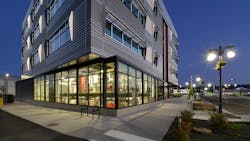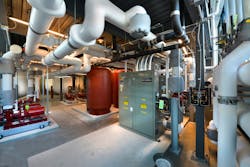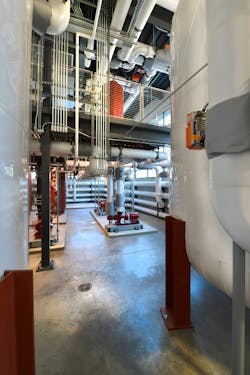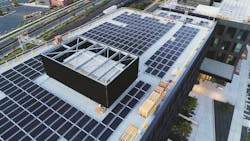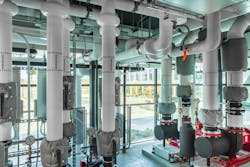Avista Demonstrates the Power of Shared Energy
Avista Utilities is reimagining the future of energy by building on its rich history of innovation and partnering with customers in new ways that can benefit the customer, utility and, ultimately, society. Avista has set clean energy goals to serve its customers with carbon-neutral electricity by the end of 2027 and carbon-free electricity by 2045. While renewable energy will play a role in the utility’s clean energy future, it realizes renewables are intermittent and can introduce instability to the grid. Therefore, innovation is essential for Avista to achieve its clean energy goals in the most cost-effective way possible for customers.
Testing new ideas also helps the utility to anticipate potential products and services — and choices — that support and engage customers at a deeper level. Two recent shared energy pilot projects in Spokane, Washington’s University District demonstrate Avista’s innovative spirit and what is possible when diverse industry partners come together to think big and test bold ideas.
The Five Smartest Blocks
Adjacent to the city of Spokane’s downtown core is an area known as the University District. The 770-acre (312-hectare) area is bisected by railroad tracks, with nearly half of the area undeveloped or ready to be revitalized. Over the last two decades, Avista and other community stakeholders have intentionally transformed the northern half of the University District into the city’s innovation and technology sector. It is now home to six universities and Spokane’s Urbanova Smart City initiative, for which Avista is a founding partner.
When the city received funding to build the University District Gateway Bridge to help extend the city’s technology sector south over the railroad tracks — and Avista learned the new bridge landed on property it owned — Avista Chairman and then CEO Scott Morris knew there was a higher purpose for the land than the utility’s original plan of building a substation to accommodate load growth. Instead, Morris had a vision to create what he called “the five smartest blocks in the world.” It would be a technology-rich space for learning, living, research and business. He imagined a development where smart grid meets smart city, meets smart building.
To help bring this vision to life, Avista strategically recruited key partners like McKinstry Co. LLC, a national leader in designing and operating high-performing buildings. McKinstry’s expertise in the built environment focused on how to optimize the building’s operation. While Avista typically focuses on delivering safe, reliable, affordable energy, it also had been exploring how the Eco-District concept might help the utility work with customers to reduce energy demand during traditional peak hours, to flatten the load curve and make better use of the existing grid.
Working together, Avista and McKinstry designed the Catalyst building and the adjacent Scott Morris Center for Energy Innovation from the ground up, with innovative systems to create an Eco-District shared energy model. The model allows the utility to partner with building owners and operators to operate their buildings in a grid-friendly manner that shares energy between the buildings and the grid. Beyond installing energy-efficient systems that reduce how much energy a building uses, Avista works with building operators to shift when they use energy, to help reduce demand during peak hours. This partnership between the utility and building owners and operators makes better use of the existing grid and can delay costly construction of the next substation to meet energy demand, ultimately making energy more affordable for customers.
With innovative approaches like the Eco-District shared energy model, the Catalyst and Morris Center buildings have created a strong foundation for the five smartest blocks in the world, which opened in September 2020.
An Eco-District Project
McKinstry developed the five-story, 159,000-sq ft (14,772-sq m) Catalyst to be Spokane’s first zero energy, zero carbon facility. That is, it uses no fossil fuels, but instead uses on- and off-site solar and other clean energy. The Catalyst building will generate about 300,000 kWh/year from rooftop solar arrays on Catalyst and the Morris Center, that is the equivalent number of kilowatts to power and sustain 27 average-sized households per year. The building features the latest smart building technologies and energy systems, including exhaust heat recovery, three 8000-gal. (30,283-L) thermal energy tanks and an electric battery with an output of 500 kW. Up to 1000 students from Eastern Washington University will study electrical engineering, computer science, and visual communication and design in the building.
While most buildings are constructed one at a time — each with a dedicated heating and cooling system and their own grid connection — Avista and McKinstry designed the Catalyst and Morris Center buildings to test a new Eco-District shared energy model, where a centralized heating, cooling and electrical system can serve the energy needs of a group of buildings.
The heart of the Eco-District is a central plant located in the four-story, 40,000-sq-ft (3716-sq m) Morris Center. The system includes on-site solar, battery and thermal storage, plus thousands of sensors throughout the buildings to track conditions in real time. The central plant, distributed energy resources (DERs) and storage assets will be coordinated to respond to utility schedules so energy consumption can be shifted to hours that minimize capacity constraints on the distribution system. The Eco-District currently provides energy to Catalyst and the Morris Center, but it will also supply up to three additional buildings in the future.
Instead of operating in silos, both Catalyst and the Morris Center have been designed to interact with each other and with the energy grid. The building operators and utility share information, enabling them to actively schedule energy to maximize the building efficiency and make the best use of the grid — all while keeping the building’s occupants comfortable.
In addition to innovating around building operations, the Eco-District energy plant is exploring unique design concepts to combine direct-current (dc) assets on the customer side of the meter. One concept involves designing and deploying a dc switchboard to combine solar, electric storage and an electric vehicle (EV) charging station behind the dc/alternating-current (ac) inverter. Throughout this process, Avista and McKinstry’s dc system design provides insights on the efficiency of these systems as well as the commercial viability of the dc system components.
Beyond The Meter
Washington State University and the Pacific Northwest National Laboratory (PNNL) are modeling the performance of the Eco-District’s central energy plant to be dispatched by Avista to support balancing services. Assets in the energy plant and buildings will respond to requests by leveraging a PNNL scalable software tool, called Volttron, to support the integration of building assets within the transactive grid. The open-source Volttron provides a platform where data and devices connect seamlessly and securely to make decisions based on user needs and preferences.
This internet of things works together with the integrated building management system to enable Avista to see beyond the meter, so it can balance on-site energy demand with on-site energy generation. Excess energy then can be used to meet demand elsewhere on the grid or stored in the site’s thermal energy tanks and battery energy storage systems. This transactive operation of the heating, ventilation and air conditioning (HVAC), DERs and building loads allows the building operator to improve overall efficiency, lower energy demand and provide cost savings.
PNNL also is developing a variety of rate designs to provide incentives for the central energy plant to respond to grid signals while maintaining value for ratepayers. PNNL and the Washington State Department of Commerce eventually will publish what they learn from this pilot project.
A Microgrid Project
The Eco-District project in Spokane is just one of the ways Avista is reimagining the energy future. A second demonstration project, the shared energy economy project focuses on exchanging energy between the utility and customers using a microgrid platform. This demonstration also is in Spokane’s 770-acre University District, where the city’s Urbanova Smart City initiative is centered.
At its core, the shared energy economy project is a microgrid. This project uses the distribution system to intertie two Washington State University buildings on the Spokane campus. This distribution system intertie can be isolated from Avista’s grid through a switch located at the point of common coupling (PCC). Each building has 100 kW of rooftop solar installed and a battery, consisting of 500 kW, 1500 kWh at one building and another 167 kW, 337 kWh at the other building.
The brain of the microgrid is Schweitzer Engineering Laboratories’ (SEL’s) microgrid controller. The microgrid controller provides the ability to island, black start and balance supply to load. In addition, the microgrid controller is integrated into the building management systems (BMS) of each building and has a predetermined prioritized load-shedding scheme to support load balancing.
Besides serving as a power island in such an event, Avista’s microgrid enables two Washington State University buildings to exchange services back and forth. Each of the buildings can coordinate their solar, storage and load assets in a way that provides mutual benefit to the building owners and the grid. This shared energy system optimizes the utility’s control infrastructure to provide mutual benefits, in addition to system resiliency.
Avista tapped POWER Engineers Inc. to act as its owner’s engineer, to help the utility with overall design, functionality and construction planning for the microgrid and the necessary components that make up the shared energy economy valuation. POWER’s team prepared a detailed road map for getting all the parts in the shared energy economy project to work together successfully, including the controls, communications and critical power systems.In addition to POWER, Avista partnered with McKinstry, Washington State University, SEL, Spirae Inc. and PNNL. The shared energy economy project was partially funded by the Washington Department of Commerce’s Clean Energy Fund project.
Tracking Energy Valuations
The shared energy economy project will evaluate a set of use cases and calculate a shared value from the perspective of the customer, utility and market. The project will measure cost, utilization and performance to balance and energy exchange between participants. After the value is determined, then mechanisms can be incorporated to automate the exchanges.
The shared energy economy project will coordinate value exchanges based on managing a group of buildings as well as solar and storage assets across the utility infrastructure. Today, many of these assets operate independently; however, in the shared energy economy project, the assets are coordinated by the advanced controls and distributed energy management systems. By orchestrating these assets, Avista recognizes a shared value may be derived.
Whether it involves sharing energy between buildings or sharing information among building owners, operators and the utility, innovation, collaboration and public-private partnerships all play a key role in making both of the shared energy projects possible. Customer engagement also is essential, and Avista’s Eco-District project invites customers to participate in the energy system at a much deeper level than ever before. The projects are an example of how utilities and developers can work together to test bold, innovative ideas and forge meaningful changes in the utility industry. Ultimately, they could lead to an affordable clean energy future for everyone.
John Gibson is director of the Avista Energy Innovation Lab and chief research and development engineer with Avista Utilities. He leads the team that develops grid products and services for Avista’s electric and natural gas customers. He has more than 25 years of experience in the electric utility industry.
Greg Clark is a seasoned engineering expert for POWER Engineers Inc. He is focused on clean, renewable energy projects, including wind energy, solar photovoltaics and energy storage applications for utility-scale generation and microgrid projects. He has strong owner’s engineer and detailed design experience and has successfully managed project teams across the U.S. and overseas.
For More Information
McKinstry | www.mckinstry.com
POWER Engineers | www.powereng.com
SEL | https://selinc.com
Spirae | https://spiraewave.com
About the Author
John Gibson
John Gibson is a chief research and development (R&D) engineer at Avista.
Greg Clark
Greg Clark ([email protected]) is a seasoned engineering expert for POWER Engineers Inc. He is focused on clean, renewable energy projects, including wind energy, solar photovoltaics and energy storage applications for utility-scale generation and micro-grid projects. He has strong owner’s engineer and detailed design experience and has successfully managed project teams across the U.S. and overseas.

